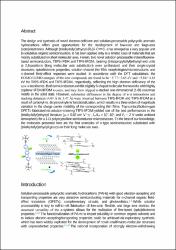Triisopropylsilylethynyl-substituted indenofluorenes: carbonyl versus dicyanovinylene functionalization in one-dimensional molecular crystals and solution-processed n-channel OFETs

Göster/
Erişim
info:eu-repo/semantics/openAccessTarih
2018Yazar
Özdemir, ResulPark, Sangyun
Deneme, İbrahim
Park, Yonghan
Zorlu, Yunus
Ardic Alidağı, Hüsniye
Harmandar, Kevser
Kim, Choongik
Usta, Hakan
Üst veri
Tüm öğe kaydını gösterKünye
Org. Chem. Front., 2018,5, 2912-2924Özet
The design and synthesis of novel electron-deficient and solution-processable polycyclic aromatic hydrocarbons offers great opportunities for the development of low-cost and large-area (opto)electronics. Although (trialkylsilyl)ethynyl (R3Si–C C–) has emerged as a very popular unit to solubilize organic semiconductors, it has been applied only to a limited class of materials that are mostly substituted on short molecular axes. Herein, two novel solution-processable indenofluorenebased semiconductors, TIPS-IFDK and TIPS-IFDM, bearing (triisopropylsilyl)ethynyl end units at 2,8-positions (long molecular axis substitution) were synthesized, and their single-crystal structures, optoelectronic properties, solution-sheared thin-film morphologies/microstructures, and n-channel field-effect responses were studied. In accordance with the DFT calculations, the HOMO/LUMO energies of the new compounds are found to be -5.77/-3.65 eV and -5.84/-4.18 eV for TIPS-IFDK and TIPS-IFDM, respectively, reflecting the high electron deficiency of the new ?-backbones. Both semiconductors exhibit slightly S-shaped molecular frameworks with highly coplanar IFDK/IFDM ?-cores, and they form slipped ?-stacked one-dimensional (1-D) columnar motifs in the solid state. However, substantial differences in the degree of ?–? interactions and stacking distances (4.04 Å vs. 3.47 Å) were observed between TIPS-IFDK and TIPS-IFDM as a result of carbonyl vs. dicyanovinylene functionalization, which results in a three orders of magnitude variation in the charge carrier mobility of the corresponding thin films. Top-contact/bottom-gate OFETs fabricated via solution-shearing TIPS-IFDM yielded one of the best performances in the (trialkylsilyl)ethynyl literature (µe = 0.02 cm2 V-1 s -1 , Ion/Ioff = 107–108 , and VT ~ 2 V under ambient atmosphere) for a 1-D polycrystalline semiconductor microstructure. To the best of our knowledge, the molecules presented here are the first examples of n-type semiconductors substituted with (trialkylsilyl)ethynyl groups on their long molecular axes.

















